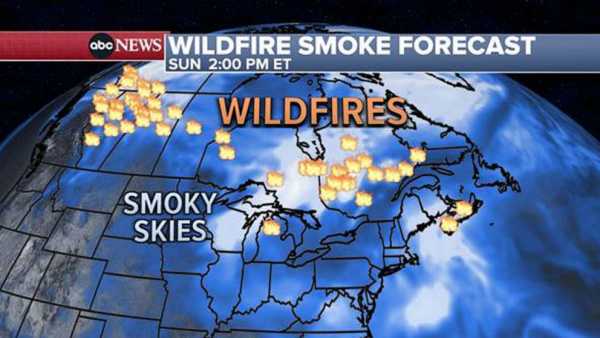Wildfires across the United States and Canada — fueled by record heat and dry conditions — could severely impact the health of millions of people.
Smoke from wildfires in several Canadian provinces, including Ontario, Quebec and Nova Scotia, led to air quality alerts throughout several states in the Midwest, mid-Atlantic and Northeast. Additionally, fires in Michigan and New Jersey have created dense fog and heavy smoke.
Inhaling toxic smoke and ash from wildfires could cause damage to the body — including the lungs and heart — and even weaken our immune systems, experts said.
MORE: At least 26 dead and 2,000 injured as wildfires rage out of control across Chile
"Wildfire smoke itself is quite a complex mixture and it's made up of fine particles … and a number of other gases, which are toxic, mainly due to the fact that wildfires burn everything so more toxic than household fires because everything has been burned," Dr. Kimberly Humphrey, a climate change and human health fellow at the Center for Climate, Health, and the Global Environment at Harvard T.H. Chan School of Public Health, told ABC News.
Fine particulate matter known as PM2.5, which is 30 times smaller in diameter than a human hair, is of particular concern.

Hose is laid down a road while firefighters tackle the Shelburne wildfires in Shelburne County, Nova Scotia, Canada, June 2, 2023.Communications Nova Scotia/via Reuters
Because these particles are too small to be seen with the naked eye, they can easily enter the nose and throat and can travel to the lungs, with some of the smallest particles even circulating in the bloodstream, according to the Environmental Protection Agency.
"The top offender here is these fine particles," Dr. Vijay Limaye, a climate and health scientist at the National Resources Defense Council, told ABC News. "That size is really important because can penetrate really deeply and wreak havoc on the body."
PM2.5 can cause both short-term health effects, even for healthy people, including irritation of the eyes, nose and throat; coughing, sneezing; and shortness of breath and long-term effects such as worsening of conditions such as asthma and heart disease.
This is especially concerning for vulnerable groups including children, pregnant people, older adults and those who are immunocompromised or having pre-existing conditions.
MORE: How woodpeckers can be used to aid in wildfire recovery
"Lower socioeconomic neighborhoods are at a higher risk as well," Humphrey said. "Often they don't have the ability for financial reasons, predominantly, and also social reasons to get away from wildfire smoke, they may not be able to shelter inside, they may not be able to afford the equipment to protect their lungs from the smoke."
Not all PM2.5 particles are the same. One study from California in 2021 found that those from wildfires can be up to 10 times more harmful than the same type of air pollution coming from combustion activity.
Being exposed to smoke can cause lung inflammation and could make it harder to remove inhaled foreign materials and bacteria, potentially increasing the susceptibility to respiratory infections, including COVID-19, according to the Centers for Disease Control and Prevention.
Depending upon the length and amount of exposure, prolonged lung inflammation could result in impaired lung function that lasts long after the wildfire has ended.
Additionally, studies have shown a link between poor air quality — which these fires have caused — and cardiovascular disease, including strokes, heart attacks, heart failure and atrial fibrillation.

Weather map of wildfire smoke forecast, June 4, 2023.ABC
Because of climate change, there will not only be more record-setting wildfires but also more people at risk of inhaling toxic smoke as well, the experts said.
"It's clear that the climate change problem is essentially creating conditions that make the fire problem and the smoke problem worse," Limaye said. "So, we're talking about, hotter days, longer wildfire, seasons, drier conditions, spring snowmelt that essentially, put more wildfire fuel in play earlier — all these kinds of converging factors."
He added, "And I think it's reasonable to expect that wildfire smoke is going to grow as a public health concern in the coming years."
Humphrey recommends that people stay aware of their local air quality and, if it reaches unhealthy levels, to wear a mask, ideally an N95.
Sourse: abcnews.go.com






